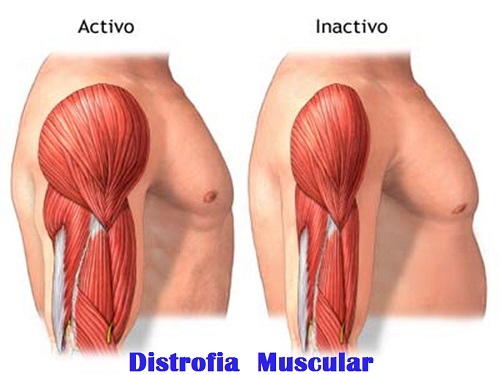Muscular Dystrophy is inherited myopathies, characterized primarily by progressively severe weakness. Although it is generally believed that inherited diseases must be due to a missing or structurally abnormal protein (either an enzyme or a structural protein), this abnormality has not been identified in any form of dystrophy. Indirect evidence implicates the muscle membranes in several forms, but this hypothesis cannot now be put to direct test. Pathologic and biochemical abnormalities can be detected in muscle, and there is no clear evidence of neural abnormality in traditional terms.
It is conceivable, however, that the funadmental abnormality is in another organ ‘such as the liver or bowel) and that the muscular abnormalities are secondary. Some authors have postulated a debatable vascular cause, one of chronic and relative ischemia. Classification. No classification of the muscular dystrophies is entirely satisfactory, but the application of clinical and genetic analysis provides the best approach at present.
The classification in the accompanying table is based upon the clearly identifiable features of Duchenne dystrophy, facioscapulohumeral dystrophy, and myotonic muscular dystrophy. Limb-girdle dystrophy is probably not a single disease, but merely encompasses cases that do not fall into the other categories. Incidence. None of the muscular dystrophies are common. Incidence rates vary from 5 per million births for facioscapulohumeral dystrophy to about 250 per million births for Duchenne dystrophy. Many cases seem to be sporadic; the mutation rate of Duchénne dystrophy is high, 7 x 10-3, and about two thirds of the cases appear sporadically, with no other affected individual in the family.
Pathology of Muscular Dystrophy
Pathologic abnormalities are restricted to skeletal muscle, sometimes involving cardiac muscle. The brain, spinal cord, and peripheral nerves are devoid of histologic change, although some authors have implicated the brain because of a seemingly high incidence of mental retardation in children with Duchenne dystrophy. Terminal pneumonia may cause changes in the lungs, and there may be a variety of associated diseases not directly linked to the dystrophy. In myotonic muscular dystrophy, however, baldness and testicular atrophy are integral parts of the disease in men, and corneal opacities affect both sexes.
The abnormalities in muscle seem to involve all fibers in random fashion. Early, there is scattered evidence of necrosis and regeneration, with prominent variation in fiber size, including many fibers much larger than nor- mal. Later, fibers disappear, to be replaced by fibrous connective tissue and fat. “Pseudohypertrophy” is probably due to both “true” hypertrophy (large fibers) and incresed axxumulation of fat and conective issue.
Diagnosis of Muscular Dystrophy
The clinical picture of Duchenne dystrophy is so characteristic that it entails little diagnostic confusion. In its first stages, some children are merely regarded as clumsy, and some receive orthopedic care because of toe-walking; otherwise the diagnosis becomes obvious. As noted, the trait is transmitted as a sex- linked recessive, and once a case is recognized, members of the family rapidly detect the signs in subsequently affected youngsters.
Once a family is known, affected individuals can be identified in the neonatal period because the serum enzymes are already markedly abnormal. Limb-girdle and faeioscapulohumeral dystrophy must be differentiated from neurogenic diseases, from congenital myopathies, and from polymyositis, as will be discussed below. Myotonic dystrophy may be confused with endocrine disorders or, because or the distal weakness, with neuropathy or amyotrophy, or with hypothyroidism or gonadal disorders.
Ocular myopathy must be differen- tiated from myasthenia gravis; this is usually not a problem because there is no fluctuation of symptoms in the myopathy, and the weakness does not respond to cholinergic drugs. The differential diagnosis of the dystrophies depends also upon the age of the patient. In childhood and adolescence, the major problems involve peroneal muscular atrophy (Charcot-Marie-Tooth) and “muscular atrophy simulating muscular dystrophy” (Wohlfart-Kugelberg-Welander). In adults, amyotrophic lateral sclerosis is the major problem. At all ages, poly- neuritis must be considered.
Muscular Dystrophy Treatment.
There is no specific treatment for the weakness of any form of dystrophy. Physical medicine, exercises, splints, braces, and currective orthopedic surgery are applied in different centers with varying degrees of enthusiasm. Some therapeutic activists claim that walking can be prolonged into late adolescence in Duchenne dystrophy. They may be correct, but it is dif- ficult to prove. The most poignant decisions concern the use or antimicrobial drugs or supported respiration for young men paralyzed from the neck down and with no hope of ultimate recovery.
The myotonia of myotonic dystrophy can be relieved by diphenylhydantoin (0.3 to 0.6 gram daily), quinine (0.3 to 1.5 grams daily), or procainamide (4 to 6 grams daily), but this is rarely the problem, and nothing can be done for the weakness. Cataracts are treated surgically upon appropriate indication, and cardiac arrhythmias or congestive heart failure are managed accordingly.

